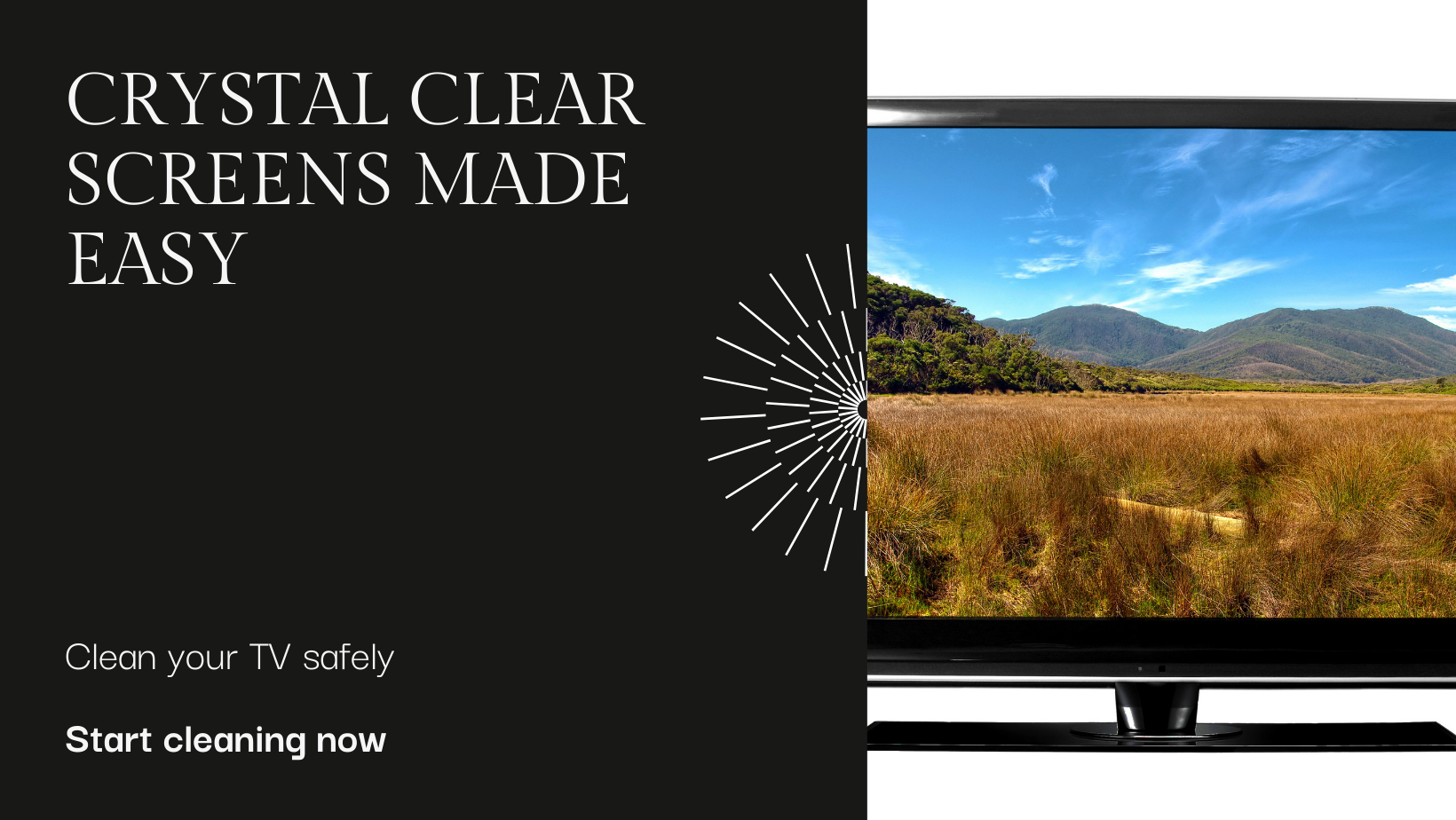How to clean your OLED tv screen
A clean TV screen can significantly enhance your viewing experience. However, cleaning a TV screen isn't as straightforward as it might seem. Different types of screens, such as LED, OLED, and flat screens, require different cleaning methods. Using the wrong materials or techniques can lead to a damaged TV screen from cleaning. This guide will provide you with the best cleaning methods for your TV screen. It will also highlight what to use when cleaning a TV screen to avoid causing any damage.
We cover a variety of materials to use and not to use when cleaning TV screens. From microfibre cloth to toilet paper and everything in between.
Understanding the Importance of a Clean TV Screen
A clean TV screen improves image clarity and color accuracy. Dust and smudges can obscure details and degrade picture quality. Regular cleaning also keeps your TV free from allergens, such as dust and pollen.
Beyond aesthetics, cleanliness reduces the risk of scratches and long-term damage. A dirty screen invites more frequent cleaning, which can wear down protective coatings. Consistent care extends the lifespan of your TV and maintains its performance. An educated cleaning regimen is key to preserving your TV's display.
Preparing to Clean Your TV Screen
Start by turning off your TV and unplugging it to ensure safety. This prevents electric shock and allows the screen to cool down, which helps avoid streaks.
Next, gather your cleaning supplies. You'll need a soft microfiber cloth, distilled water, and possibly a mild screen-cleaning solution. Avoid using any paper towels or rough fabrics.
Here’s what to do before you start cleaning:
- Make sure your room has adequate light for visibility.
- Wash your hands to avoid transferring oils or dirt.
- Remove any nearby clutter to have a clear workspace.
Step-by-Step Guide to Cleaning Flat Screen TVs

Begin by gently dusting the screen using a microfiber cloth. This helps remove loose particles without scratching the screen. It's a crucial first step. When dealing with more stubborn smudges, lightly dampen your cloth with distilled water. Ensure the cloth is not overly wet to avoid any liquid running into the screen’s edges.
Use gentle pressure and wipe in horizontal or vertical motions. Avoid circular motions as these can cause streaks or smudges to smear. If the dirt is persistent, you may use a designated screen-cleaning solution. Apply it to the cloth, never directly onto the screen.
After cleaning, allow the screen to dry completely before turning it back on. This ensures no moisture interference with the electronics.
Cleaning LED and OLED TV Screens
LED and OLED screens require special care. Their advanced technology is more sensitive to pressure and cleaning methods. Always use a very soft cloth. A mixture of distilled water and white vinegar can clean LED and OLED screens effectively. Use a 50/50 solution and apply it to the cloth. Remember, less is more.
Wipe the screen gently, using only light pressure. Avoid using excess force as this can damage delicate pixels on these screens. Allow the screen to air dry before powering it back on to ensure it’s completely dry and no liquid enters the electronic components.
Addressing Common Cleaning Challenges
Dealing with streaks can be frustrating. To prevent them, ensure your cloth is only dampened, not soaked. Dry streaks with a clean section of the cloth.
Dust can quickly return due to static electricity. Using a slightly damp cloth can help reduce static buildup and repel dust.
Fingerprints are common issues on screens. For tough smudges, go over the area with gentle, repeated passes until the marks fade. Patience and persistence will yield the best results.
What to Avoid When Cleaning Your TV Screen
Using the wrong materials can harm your TV screen. Avoid cleaners with alcohol, ammonia, or strong chemicals as they might damage delicate surfaces. These can dull screen finishes over time.
Do not use paper towels, napkins, or toilet paper. They might seem soft, but can cause scratches and leave behind lint. Instead, opt for a high-quality microfiber cloth.
Here is a quick list of materials to avoid:
- Harsh chemical cleaners (alcohol, ammonia)
- Paper towels and similar abrasive products
- Excessive water or any liquid applied directly on the screen
Protect your investment by steering clear of these materials and methods. They can lead to a damaged TV screen from cleaning mishaps.
Homemade Cleaning Solutions vs. Commercial Products
Choosing between homemade and commercial cleaning solutions depends on your preferences. Homemade mixtures, like a vinegar and water solution, are cost-effective and easy to prepare. They're gentle yet effective.
In contrast, commercial products are specifically formulated for screens. They might provide conveniences like added anti-static properties. They often promise streak-free cleaning results.
Here's a simple comparison:
- Homemade solutions: cost-effective, easy to make, gentle
- Commercial products: ready-to-use, anti-static, streak-free
Both methods have pros and cons. Consider your needs and budget to decide the best cleaning for your TV screen.
Maintaining Your TV Screen Between Cleanings
Keeping your TV screen clean doesn't always require a full clean every time. Regular dusting with a microfiber cloth helps prevent build-up. Dust can affect image quality over time.
Consider using a screen protector. It minimizes smudges and fingerprints, reducing the need for frequent cleaning. It also provides extra protection.
A clean environment reduces dirt accumulation. Simple efforts like maintaining a dust-free room can make a big difference. These habits ensure the longevity of your TV screen.
Safety Tips and Precautions
Before cleaning, always unplug your TV. This simple step helps prevent electric shock. Safety must come first in any cleaning process.
Avoid putting too much pressure on the screen. Excessive force can damage delicate components. Gentle wiping is more effective and safer.
Use cleaning solutions in a well-ventilated room. It reduces the risk of inhaling fumes. Prioritize your health while ensuring a spotless screen.
The Do's and Don'ts of Cleaning TV Screens
Knowing the right and wrong methods ensures screen longevity. Correct cleaning prevents potential damage. Here are key pointers to follow.
- Do's:
- Use microfibre cloth or microfiber cloths to reduce scratches.
- Gently wipe in one direction to avoid streaks.
- Stick to a gentle microfiber cloth and dry cloth for cleaning anti glare coating glasses and TV screens.
- Always gently wipe the screen TV with soft dry cloths and screen cleaner.
- Follow your TV manufacturer's guidelines.
- Don'ts:
- Avoid paper towels and rough fabrics.
- Don't use harsh chemicals like alcohol-based cleaners or ammonia.
- Never spray cleaner directly on the screen.
- Remember a small amount of alcohol-based cleaners can damage your TV screen.
What other cloth is recommended for cleaning the TV screen? You can use lint free cloth as it does not leave behind fluff or lint. These simple rules aid in maintaining a pristine TV screen. Consistent care keeps your screen looking sharp. Follow these tips for best results.
Conclusion: Ensuring Longevity and Performance of Your TV
A TV screen is a delicate surface, so always be cautious when cleaning it. A soft, microfiber cloth is the best way to wipe away dust and smudges without scratching the screen. Avoid using harsh chemicals or abrasive materials that can cause permanent damage. These simple tips can keep your TV screen looking crystal clear for years.
By taking care when cleaning your TV, you can extend its lifespan. Proper techniques and gentle products protect your investment. Avoiding common cleaning mistakes ensures your TV maintains top performance. With consistent care, your screen will remain bright and clear, providing excellent viewing experiences for years to come.
